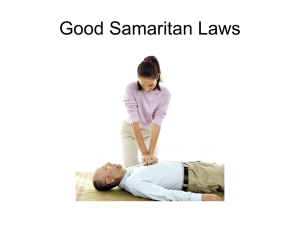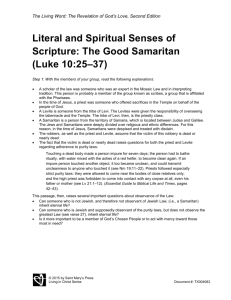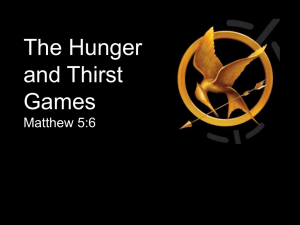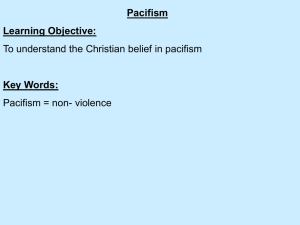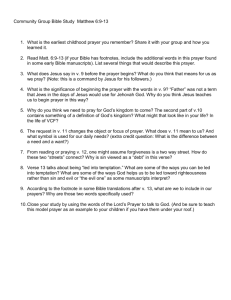Unit 2.7 Caring for all Creation - Catholic Education Office Sydney
advertisement
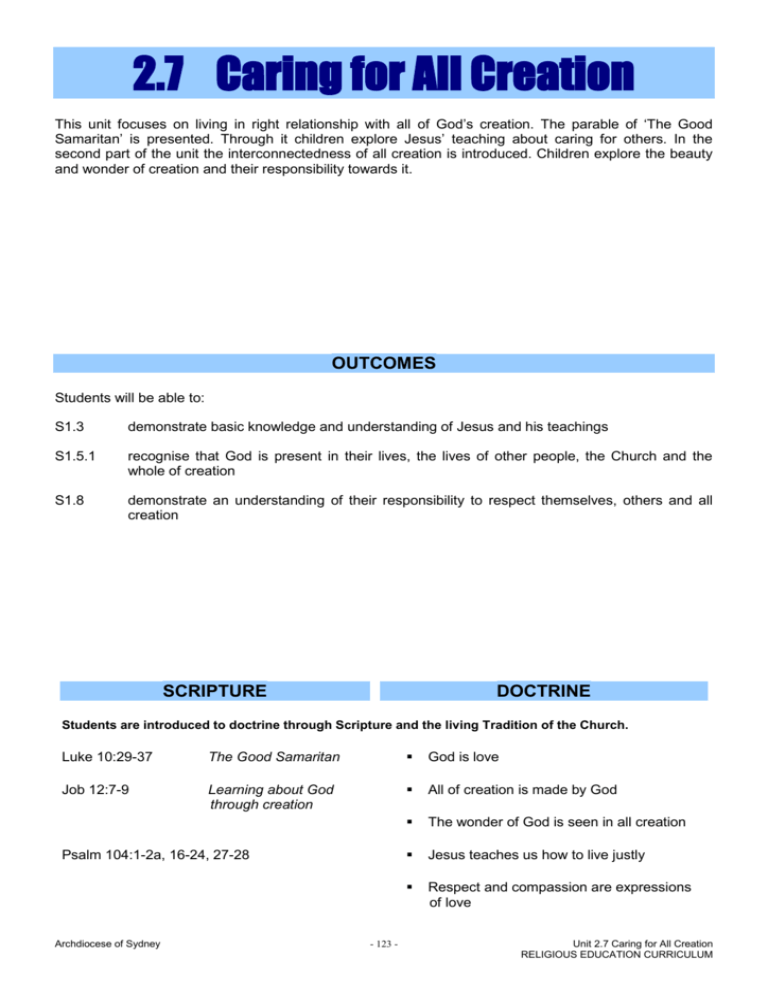
2.7 Caring for All Creation This unit focuses on living in right relationship with all of God’s creation. The parable of ‘The Good Samaritan’ is presented. Through it children explore Jesus’ teaching about caring for others. In the second part of the unit the interconnectedness of all creation is introduced. Children explore the beauty and wonder of creation and their responsibility towards it. OUTCOMES Students will be able to: S1.3 demonstrate basic knowledge and understanding of Jesus and his teachings S1.5.1 recognise that God is present in their lives, the lives of other people, the Church and the whole of creation S1.8 demonstrate an understanding of their responsibility to respect themselves, others and all creation SCRIPTURE DOCTRINE Students are introduced to doctrine through Scripture and the living Tradition of the Church. Luke 10:29-37 The Good Samaritan God is love Job 12:7-9 Learning about God through creation All of creation is made by God The wonder of God is seen in all creation Jesus teaches us how to live justly Respect and compassion are expressions of love Psalm 104:1-2a, 16-24, 27-28 Archdiocese of Sydney - 123 - Unit 2.7 Caring for All Creation RELIGIOUS EDUCATION CURRICULUM SPIRITUAL REFLECTION FOR TEACHERS Imagine you were chosen to represent humanity at a sitting of the World Council of Creation. It is a gathering that meets once a century at which each species and landform has a representative and an equal voice in discussions and decision making. The theme of the gathering is ‘Seeking harmony and celebrating creation’. Each species has been asked to make an account of the contributions they have made to the world over the last century and outline what they are doing to promote right relationships and harmony within their species and throughout creation. You are about to address the council on behalf of humanity. How do you feel about having to make this address? Why? What are some of the ways humanity has successfully responded to God’s call to live in harmony with one another and all of creation? Name some of the things that humanity is doing to protect, enhance and enrich creation. In what ways has humanity failed at times to live in harmony with one another and all of creation? Where in your life do you see the need for growth and change in order to bring about right relationships? CATECHISM OF THE CATHOLIC CHURCH Excerpts from the Catechism of the Catholic Church are included below as information for teachers. They present the Church’s teachings contained in the unit. 341 The beauty of the universe: The order and harmony of the created world results from the diversity of beings and from the relationships which exist among them. Man discovers them progressively as the laws of nature. They call forth the admiration of scholars. The beauty of creation reflects the infinite beauty of the Creator and ought to inspire the respect and submission of man's intellect and will. 353 God willed the diversity of his creatures and their own particular goodness, their interdependence, and their order. He destined all material creatures for the good of the human race. Man, and through him all creation, is destined for the glory of God. 1825 Christ died out of love for us, while we were still "enemies." The Lord asks us to love as he does, even our enemies, to make ourselves the neighbor of those farthest away, and to love children and the poor as Christ himself. The Apostle Paul has given an incomparable depiction of charity: "charity is patient and kind, charity is not jealous or boastful; it is not arrogant or rude. Charity does not insist on its own way; it is not irritable or resentful; it does not rejoice at wrong, but rejoices in the right. Charity bears all things, believes all things, hopes all things, endures all things." 2447 The works of mercy are charitable actions by which we come to the aid of our neighbor in his spiritual and bodily necessities. Instructing, advising, consoling, comforting are spiritual works of mercy, as are forgiving and bearing wrongs patiently. The corporal works of mercy consist especially in feeding the hungry, sheltering the homeless, clothing the naked, visiting the sick and imprisoned, and burying the dead. Among all these, giving alms to the poor is one of the chief witnesses to fraternal charity: it is also a work of justice pleasing to God: He who has two coats, let him share with him who has none and he who has food must do likewise. But give for alms those things which are within; and behold, everything is clean for you. If a brother or sister is ill-clad and in lack of daily food, and one of you says to them, "Go in peace, be warmed and filled," without giving them the things needed for the body, what does it profit? Archdiocese of Sydney - 124 - Unit 2.7 Caring for All Creation RELIGIOUS EDUCATION CURRICULUM SCRIPTURE: BACKGROUND INFORMATION Luke 10:29-37 The Good Samaritan “What must I do to inherit eternal life?” The answer to this question comes in the form of the Shema, that ancient Jewish prayer in Deuteronomy 6 plus a line from the Book of Leviticus 19 about loving your neighbour as yourself. How well do we love ourselves? The meaning here suggests we should love ourselves as much as God loves us. But who is my neighbour that I must love as I love myself? The parable Jesus tells to answer this question is complex while appearing simple, which is the case with most parables. The parable depicts a despised foreigner helping a battered and robbed Jew. The Samaritan / foreigner is generous above the call of duty by covering all the expenses the wounded man incurs. The innkeeper is also trusting, accepting the promises of the Samaritan to repay him. The parable functions on two levels – firstly, loving those we consider unlovable and secondly, the image of the generous Samaritan. Parables are nearly always about God and here we have a story of generous love that has no limits, like a blank cheque. That is the kind of God we have, who writes blank cheques and trusts us to use them responsibly. Job 12:1-9 Learning about God through creation Here we have one of the many gems from the Book of Job - a book that tries to come to terms with the problem of suffering. These verses come from one of Job’s longest speeches. He is strongly protesting that his conscience is clear. He is challenging the theology of his day that sees suffering as a punishment for sin. He rightly knows that good people suffer too. So these verses are part of a rather sarcastic confrontation Job has with his friends and with his society. He claims that true wisdom can be found by reflecting on creation, indeed by communicating with created things – “all creatures great and small the good Lord made them all.” He points out that his friends’ theology is wrong. Job maintains they could learn more about life and God from wisely contemplating creation. Psalm 104:1-2a, 16-24, 27-28 The entire book of Psalms is a collection of 150 psalms in toto. They are the prayers of the people and range across the centuries of composition of the Hebrew Scriptures. So some are very old (oral tradition – from 2000 BC on) and others relatively new - from after the exile (5th – 3rd century BC). There are many different types of psalms in the collection – hymns of praise (Ps 104), laments (Ps 22), royal psalms (Ps 2), wisdom psalms (Ps 111), liturgical psalms (Ps 134) and historical psalms (Ps 105). Psalm 104 is a beautiful hymn in praise of God the creator who provides and maintains the habitable world. There is much in psalm 104 that parallels the first two chapters of Genesis – those great stories of creation. In addition there is presented here the refreshing idea of God continually renewing creation. Clearly this was the writer’s worldview. The idea of on-going recreation of the world is reminiscent of the first breath God breathed into humanity to instil the life force (Genesis 2:7). But the wonderful suggestion of the psalm is that it keeps recurring. Life is constantly renewed - quite a green and ecological thought that we can and must support and not hinder. Archdiocese of Sydney - 125 - Unit 2.7 Caring for All Creation RELIGIOUS EDUCATION CURRICULUM SUGGESTED ASSESSMENT Suggestions for determining students’ development towards the achievement of the outcomes are included below: S1.3 demonstrate basic knowledge and understanding of Jesus and his teachings The students typically might: retell or illustrate part of the parable explain who was the neighbour and why explain the consequences of various actions S1.5.1 recognise that God is present in their lives, the lives of other people, the Church and the whole of creation. The students typically might: S1.8 discuss what is good about an aspect of creation compose prayers of praise to God for creation demonstrate an understanding of their responsibility to respect themselves, others and all creation The students typically might: express ideas about ‘who is my neighbour’ identify ways people care for others and creation write prayers of petition Archdiocese of Sydney - 126 - Unit 2.7 Caring for All Creation RELIGIOUS EDUCATION CURRICULUM RESOURCES To Know Worship and Love – Book 2, Chapters 13 and 16 (2005), James Goold House Publications, Melbourne, Victoria To Know Worship and Love – Big Book, Parables Jesus Told, ‘The Good Samaritan’ Teacher Resources Ashley M, “Behaviour change and environmental citizenship: a case for spiritual development?” International Journal of Children’s Spirituality, Vol 5, No 2, (2000), p141 Benson S, (2993), Look and Wonder, Part 1, Teacher’s Book, The Council for Christian Education, Victoria Bretherton B, (2002), Praying with Children Social Science Press, Australia Catholic Education Office, Bathurst, (2001), Breathing Life into the Classroom, Catholic Education Office, Bathurst Cooney J & Burton K, (1986), Photolanguage Australia: Human Values, Catholic Education Office, Sydney Edwards C and Buxton L, (1997), Guyunggu, Catholic Schools Office, Broken Bay Privett P, (2003), Living in a Fragile World, The Bible Reading Fellowship, Oxford, England Reehorst J, (1986), Guided Meditations for Children, Wm C Brown Company Publishers, Dubuque, Iowa Audio Visuals Sydney Catholic Education Office, (2003), Creative Arts K-6: Dance and Drama: Moments and Movements in Life, DVD Catholic Education Office, Leichhardt, Sydney Sydney Catholic Education Office, (2003), Creative Arts K-6: Inspiring Images, DVD Catholic Education Office, Leichhardt, Sydney Children’s Literature Baker J, (1990), Where the Forest Meets the Sea Walker Books, Australia Baker J, (2002), Window, Walker Books, Australia Foreman M, (2004), One World, Anderson Press, London Wilson M, (2005), Prayer for the Animals, Lothian Books, Melbourne Websites http://images.google http://www.ncls.org.au/default.aspx?docid=3072 These sites have a large range of photographic images of people, animals, plants. http://kcm.co.kr/glp/jerusalem/ho/ho069.jpg http://www.ancientsandals.com/pictures/jericho.htm Photographs of Jericho NOTE: See RE Online for additional resources for this unit. Archdiocese of Sydney - 127 - Unit 2.7 Caring for All Creation RELIGIOUS EDUCATION CURRICULUM UNIT CONTENT A: WHO IS MY NEIGHBOUR? The parable of The Good Samaritan helps us to learn about loving others. Students will: listen and respond to the parable of The Good Samaritan reflect on their relationships with other people BACKGROUND INFORMATION This Unit Content explores what it means to love your ‘neighbour’ as yourself. In the Gospel of Luke, a lawyer asks Jesus: What must I do to inherit eternal life? and Who is my neighbour? Jesus responded to the lawyer’s question ‘Who is my neighbour?’ with a story/parable rather than simply telling him the answer. We, too, put this story before the children and allow it to speak to and challenge them at their level. We need to remember that this story has the power to challenge and guide them not only now but throughout their lives. At the end of the story Jesus asks the lawyer, “Which of these three, do you think, was a neighbour to the man who fell into the hands of the robbers?” Jesus’ way of responding to the lawyer in this story can be a model for teachers. Rather than provide the answers for children, we can listen to their responses and provide opportunities for them to explore and express their understandings. Children of this young age are capable of making choices about how to treat others. At a very simple level they are able to explore the relationship between cause and effect of actions. In the unit, the children hear and become familiar with the story, ‘The Good Samaritan,’ as it is told with 2D materials. Through the wondering they engage with the story and its challenges. The children wonder about the behaviour of the priest, Levite and Samaritan; the possible reasons for their decisions; and the generosity of the Samaritan. The unit provides the children with the opportunity to explore the meaning of ‘neighbour’ as expressed in the story and to consider who their ‘neighbours’ are. To help friends and those who are popular is far easier than to do the same with the unpopular. To include the outsider demands courage. Prayer in the unit provides opportunities to ask for help and courage to build better relationships, ones which are life giving and do not oppress, hurt or exploit others. Archdiocese of Sydney - 128 - Unit 2.7 Caring for All Creation RELIGIOUS EDUCATION CURRICULUM SUGGESTED TEACHING/LEARNING STRATEGIES The following suggested activities are organised around the key elements of Telling the Story, Wondering, Exploring and Prayer. Teachers select, adapt or substitute activities, ensuring that each of the abovementioned elements is evident in the cycle of learning. Tell the story of ‘The Good Samaritan’ based on Lk 10:29-37 in KWL ch 16. See ‘Resource Sheet 1’ and RE Online for 2D masters. Use the ‘I wonder’ statements that refer to the events and characters of the story. Leave the other ‘I wonders’ for use after reading the story in the KWL book. Provide opportunities for the children to explore the story through one or more of the following suggested activities. Ideally, organise these activities so that choice is offered to children. While the class is engaged in ‘exploring’ work, talk with individual students about their work using open statements, eg “Tell me about the part of the story you have chosen for your work.” Statements will depend on the student’s work. o Students choose a part of the story they would like to draw or paint. o Individually or in small groups, retell the story using the 2D story materials. o In a small group, using clothes from the dress-up box, retell the story. Rotate the characters on subsequent retelling. o In the role of the wounded man, write a letter to the Good Samaritan. Revisit the story using the KWL Big Book, Parables Jesus Told, ‘The Good Samaritan’. Provide the opportunity for children individually or in small groups to read the Big Book themselves. Lead students in a guided meditation on The Good Samaritan - adapt from Guided Meditations for Children, p33. Display pictures of children and adults in various situations, eg a child alone in the playground watching others play. Perhaps use Photolanguage Kit. See Breathing Life into the Classroom p125 for use of this resource. Discuss what may be happening in the pictures. What would it feel like if…? Who may have passed by? Who could do something? What could they do? Identify those responding to the needs of others, showing care and compassion. Children each choose a picture to be used as a stimulus for praying for others. Invite children to close their eyes and quietly think about the picture they chose. Allow a few minutes silence for this. Invite children who wish to share a prayer with the class. Conclude with a prayer which includes some of the reflections of the children. See Praying with Children, p25. Read the first paragraph in KWL p158. Consider with the children the question, Who is my neighbour? at school, family, sports groups, friends. Use the remainder of the ‘I wonders’ at the end of the chapter. Archdiocese of Sydney - 129 - Unit 2.7 Caring for All Creation RELIGIOUS EDUCATION CURRICULUM Read and discuss the story of ‘The Good Samaritan’ and the illustrations in the KWL book. Locate Jerusalem and Jericho on a map of Israel. Show pictures of the road from Jerusalem to Jericho. See http://kcm.co.kr/glp/jerusalem/ho/ho069.jpg and http://www.ancientsandals.com/pictures/jericho.htm Guide the children to think about those they find difficult to help. The children write or draw about this in their journals. They could also write a prayer asking for help when interacting with others. Use the prayer in KWL p165 at various times throughout the unit. Proclamation of the Word (with action): Gospel Procession: Children form a guard of honour to welcome the Bible into their midst. As the book bearer and candle bearer process through the guard of honour, the children bring their hands to the front and hold them out in a receiving position, palms upward. When the Bible has arrived at the front of the class, children drop their hands to sides and move in procession to form a circle around the Word. The children sit and place hands on laps, with palms facing upward in a receiving position to listen to the Word of God. (Praying with Children, B Bretherton). Proclamation: Leader: A reading from the Gospel of Luke Read Luke 10:29-37 Leader: This is the Gospel of the Lord. All: Praise to you, Lord Jesus Christ. Prayers of Petition: With the children, compose prayers of petition for ‘neighbours’ and themselves, eg: To ask others to join in our games God of all people, we ask your help To think about how people are feeling God of all people, we ask your help Home Activity: Students take their copy of To Know Worship and Love home. They read and talk about the chapter with their parents. Parents are also invited to do the Home Activity. Archdiocese of Sydney - 130 - Unit 2.7 Caring for All Creation RELIGIOUS EDUCATION CURRICULUM UNIT CONTENT B: WITH ALL CREATION The whole of creation is interconnected. Students will: explore the beauty and diversity of creation consider ways to take care of creation BACKGROUND INFORMATION This Unit Content follows directly from the previous one. Unit Content A examined our responsibility to other people and Unit Content B examines our responsibility towards creation. Children of this age have a fascination with the diversity and beauty of creation. It is suggested that many of the activities in the first part of this Unit Content take place outside the classroom, where children have direct contact with creation in the immediate environment – parks, gardens and playground. This hands-on experience engages the way children naturally play and delight in creation as they explore its beauty. This Unit Content not only explores the beauty of creation but also its interconnectedness. The world is made up of many ecosystems all dependent on each other. What happens to one part of creation affects the other parts. There are a number of children’s picture books which deal with this wonder. The exploration could be extended in the Science program, eg examining the way wetlands, rainforests or river systems work. An appreciation of the wonder of the natural world implies a desire to care for it and allow it to flourish. This is not always the case. Martin Ashley has written of the importance of recovering a spiritual dimension in the area of environmental education. His research in the world of school education suggests that awareness and understanding are not sufficient to effect behavioural change. What is needed is a movement away from seeing the environment as another commodity, an object to be manipulated and a place where humans set themselves over and against it. He calls for a spiritual understanding of interconnectedness, of feelings of oneness with the ultimate, of the reintegration of subject and object. This spiritual dimension offers the possibility of integration between deeply held values, belief and behaviour. Ashley’s research suggests that when these two dimensions are separated, then people will speak about their concern for the environment but in their actions they will do little, or even the opposite of what they say. 1 1 M Ashley, “Behaviour change and environmental citizenship: a case for spiritual development?” International Journal of Children’s Spirituality, Vol 5 No. 2, (2000): p141, quoted in Living in a Fragile World, Peter Privett Archdiocese of Sydney - 131 - Unit 2.7 Caring for All Creation RELIGIOUS EDUCATION CURRICULUM SUGGESTED TEACHING/LEARNING STRATEGIES The following suggested activities are organised around the key elements of Telling the Story, Wondering, Exploring and Prayer. Teachers select, adapt or substitute activities, ensuring that each of the abovementioned elements is evident in the cycle of learning. Provide opportunities for children to explore the wonder of creation: o Creation walk. Take the children for a walk. Look for as many wonders of God’s creation as they can find, eg the intricacy of a leaf, the ants at work in the ground, the warmth of the sun, the mystery of the clouds. See ‘Resource Sheet 2’ for suggestions. o Go on an excursion to botanic gardens, wetlands, river, rainforest. o Place hoops down in an open area. Small groups of children examine the space inside their hoop. They record their findings of natural objects. Look and Wonder Part 1, p51. o Keep living things in the classroom, eg goldfish, ant farm, grow sprouts and mushrooms. o Watch the movement of birds, clouds and the wind. o Show audio-visuals of nature programs. o Read literature and science books to the children which demonstrate the interconnectedness of creation, living in harmony with God’s creation, and showing respect for the earth. Read and discuss the illustrations and question posed in KWL ch 13, pp138-140. Use the prayer in KWL ch 13, p145 at various times during the unit. The students are given the opportunity to respond to the KWL text (including illustrations) and experiences through one or more of the following suggested activities: o In small groups, explore the diversity of creation using a search of http://images.google or http://www.ncls.org.au/default.aspx?docid=3072 for a chosen aspect of creation, eg dogs, birds, fish, people. o Make models of favourite living things using clay, plasticene or play dough. o Make a favourite landscape picture, perhaps from a holiday or an excursion. Add plants, animals and people to the scene. o Spend time with the class animals and plants. o Write about a favourite part of creation, or compose a prayer of praise or thanks. View ‘On Location’ from ‘Dance and Drama: Moments and Movements in Life’ in a mood of prayer and reflection. Facilitate through questioning the children’s realisation of the Australian bush as a powerful symbol of rebirth and renewal. During follow-up reflection time, invite the children to express poetically the element of creation, in the dance shown, that has the most significant meaning for them. The children can also respond by creating their own dance/movement with materials as a prayer of praise. Read ‘Prayer for the Animals’ by Mark Wilson as a stimulus for children to create their own prayer and painting for an element or creature of creation. Use acrylic paints, in the style of Mark Wilson, using the wet-on-wet technique as demonstrated in Inspiring Images, Part 2 ‘Painting – The WetOn-Wet Technique’. The children’s work could then be sequenced in the style of the book to create a class prayer slide sequence with appropriate music. Archdiocese of Sydney - 132 - Unit 2.7 Caring for All Creation RELIGIOUS EDUCATION CURRICULUM Guide children to create six circles with pencil on a large piece of art paper. These circles will be used to create six mandalas representing the six elements of creation, ie air, water, light, earth, heat and darkness. Use a broad range of clip-art and graphics to guide simple drawings to be coloured. The children can match their mandalas to psalms, which use these elements to praise God through creation. Read KWL ch 13, pp141-143; discuss the illustrations and questions posed on p141. Continue the discussion using the first three ‘I wonders’. How can the children care for the classroom, other children’s property, the playground, their pets, parks, backyard. Using the creation visuals from Year 1, the class retells the story of creation. Children share their favourite part or parts of creation. For each visual tell what has happened that is not good, and what is destroying the goodness of creation. For example: o Place sheer black material over ‘the heavens’ visual. Say: The smoke from cars and factories rises up and covers the earth. o See Living in a Fragile World for exploration of conservation strategies pp27-31. o Use the children’s creative work from the six circles activity. Class discuss their choice of work and what is happening to destroy that aspect of creation. Read children’s literature on the treatment of the planet, eg Where the Forest Meets the Sea, Window or One World. Use ‘wondering’ statements to engage with the stories, eg I wonder … - what God might say to the world - what we might say to God Provide time for the children to reflect on ways they have shown care for the earth this week. Discussion may lead to a collective decision of action, to be undertaken by the class to care for the school environment. Include prayer throughout the unit: o Meditative Prayer: Choose a short phrase adapted from one of the Scripture passages from the unit which is easy to learn, eg ‘My life is in God’s hand’ (Job 12:10), ‘God how great you are’ (Ps 104). Repeat this phrase at various times during the day. See Praying with Children, p31 for other meditative prayer suggestions. o Litany of Praise: Children contribute their own phrases to the litany, eg: For the sun and sky We praise you, God For the moon and stars We praise you, God o Prayer of Thanksgiving for animals: Include what we can learn from the creatures of the earth, eg Thank you for the birds of the air. They have such beautiful and colourful feathers. They always have a home in the trees. See Psalm 104. o Prayers for the earth, people of the world, creation. Home Activity: Students take their copy of To Know Worship and Love home. They read and talk about the chapter with their parents. Parents are also invited to do the Home Activity. This could be done with the whole family. Children share where they went and what they did with the class. Archdiocese of Sydney - 133 - Unit 2.7 Caring for All Creation RELIGIOUS EDUCATION CURRICULUM Resource Sheet 1 The Good Samaritan KWL Chapter 16 (Luke 10:29-37) YOU WILL NEED: Light yellow or cream felt background (the area between Jericho at Jerusalem was desert) Felt road and rocks 2D characters: Good Samaritan, 2 robbers, priest, Levite, man, donkey (see RE Online for 2D masters) Jericho Jerusalem Children are seated in a semi-circle ready to listen to the story. When the children are settled, go to the shelf and carry the materials as you would the Bible. Place these beside you. Place the felt background in the middle of the story space. Place the road on top of the background. Place the rocks on both sides of the road with robbers under the rocks. Place Jericho at the far end of the road away from you. Place Jerusalem at the end closest to you. One day Jesus was teaching the people to love God and their neighbours. A man stood up and asked Jesus a question. “And who is my neighbour?” To answer him, Jesus told this story. Place man on the road near Jerusalem. Move him down the road a little way as you say: Once a man was going down a lonely road from Jerusalem to Jericho, Bring robbers out and place on top of the man. when he was attacked by robbers. They took all that he had and bashed him until he was half dead. Move man to side of road. Remove robbers. They left him on the side of the road. Move priest down middle of road from Jerusalem. When he comes to the wounded man, move priest to the other side of the road, and then down to Jericho. A priest who served in the Temple walked by. He saw the wounded man but crossed to the other side and passed by. Move Levite down middle of the road from Jerusalem. When he comes to the wounded man, move Levite to the other side of the road, and then down to Jericho Next, a Levite, a man who helped in the Temple came along. He also crossed the road and hurried past. Move Samaritan and his donkey down middle of road from Jerusalem. When he comes to the man, move Samaritan over next to him. But, then, a Samaritan came down the road. He saw the man and felt sorry for him. He knelt down and cleaned his injuries with oil and wine. Place wounded man on donkey. He bandaged him, lifted him on to his donkey. Archdiocese of Sydney - 134 - Unit 2.7 Caring for All Creation RELIGIOUS EDUCATION CURRICULUM Move Samaritan and wounded man almost to Jericho. He and took him to a place where he could be looked after. The next day, the Samaritan gave the man in charge enough money to look after the injured traveller. When Jesus had finished telling this story he asked, “Which of these three men was a true neighbour to the wounded man?” Remove priest, Levite and Samaritan. Move wounded man to the centre of the space. Place priest next to the wounded man. I wonder if the priest, who served in the Temple, was a good neighbour. Replace priest with the Levite. I wonder if the Levite, who helped in the Temple, was a good neighbour. Replace Levite with Samaritan. I wonder who was a good neighbour in the story. The people listening to Jesus said, “The one who looked after the wounded man was a true neighbour.” Jesus ended the story by saying, “Go, and do the same yourself.” Engage with ‘I wonder’, KWL p164. Carefully pack story materials into storage box and put on shelf. Ensure that children are watching so they know how to pack the materials away and where to find them. Archdiocese of Sydney - 135 - Unit 2.7 Caring for All Creation RELIGIOUS EDUCATION CURRICULUM Resource Sheet 2 First Touch of Land Children take off their shoes (if safe). Guided by the teacher they then walk to a natural area in the playground. Allow them time to feel the different surfaces underfoot. Children close their eyes and listen to the sounds around them (both bush and other sounds). Allow the children time to tell you the sounds that they hear. Allow the children to listen again trying to block out the artificial sounds. Instruct the children to place their hands by their side, feel the grass under their feet, then plant their feet and be still. Do a small meditation exercise so the children are now more aware of different sounds. For example can they feel the sun on their head or shoulders, can they feel the wind? Now relax and listen. Again give the children the opportunity to share with you the sounds that they can hear. Guide the children through the playground, being aware of the different scents around them. On a number of occasions, take the children on tracks in the school grounds where they can see what is happening. For example: Find an ant trail, look for the nest, and observe how ants react to different weather, look at ant behaviour, eg rubbing feelers to tell others where food is. Explain to the children that the ants have as much right to be in that place as they have. Revisit on a number of occasions the tracks that the children have walked, to observe changes and/or differences. (Edwards C and Buxton L, (1997), Guyunggu: an aboriginal way of being, p31) Archdiocese of Sydney - 136 - Unit 2.7 Caring for All Creation RELIGIOUS EDUCATION CURRICULUM

